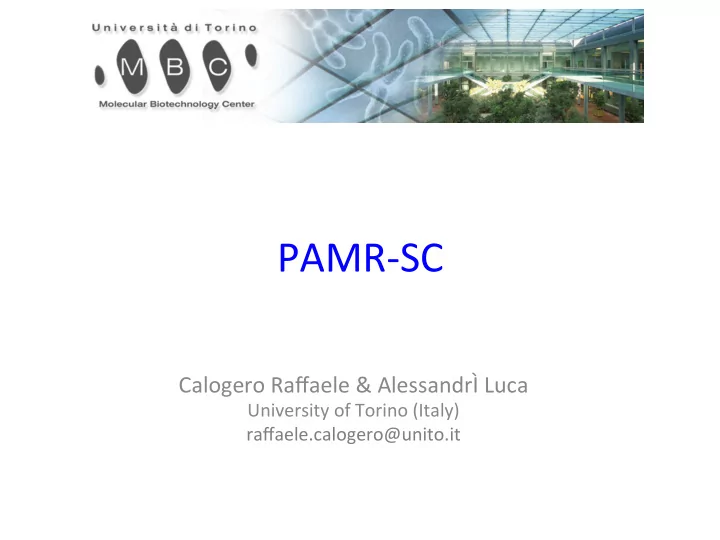

PAMR-SC Calogero Raffaele & AlessandrÌ Luca University of Torino (Italy) raffaele.calogero@unito.it
SubpopulaFon OrganizaFon Of Innate T-cells • We have a collaboraFon with Prof. De Libero, Basel University, for the analysis of single cell data to detect the presence of sub-populaFons within 4 cell populaFons, ~500 cells/group: – AcFvated T cells expressing the TCR γδ; – ResFng TCR γδ cells; – AcFvated MAIT cells, – ResFng MAIT cells. • Aim: – IdenFfy a set of gene products, that can be use in mulF- color FACS analysis to study the detected sub-populaFons.
Smart-seq2* & Single Cell FACS SorFng, 96 cells/plate Lysis, RT, Library Prepare cells Sort cells Sequence AmplificaFon preparaFon BD FACSAria II™ Single cell cDNA Pooled single cell HiSeq 2000 Special Order System cDNA library 400 300 Frequency 200 100 0 0 2 4 6 8 10 *Adapted from Picelli et al. Nature Methods 10, 1096–1098 (2013)
Workflow • Data reducFon. • Cluster data to idenFfy sub-populaFons • Checking robustness of the sub-populaFon clusters • SelecFng the main gene players in clusters formaFon.
Data reducFon Good-Turing model of Lorenz-staFsFc sample coverage 800 1 Simpson diversity Preseq coverage 600 0.5 400 0 200 -0.5 0 -1 QC pass QC fail QC pass QC fail *Diaz et al. BioinformaFcs (2016) 32 (14): 2219-2220 # Daley et al. BioinformaFcs (2014) 30 (22): 3159-65
Data reducFon
DetecFng cell heterogeneity hlp://bioconductor.org/packages/release/bioc/html/SIMLR.html Bo Wanget al Biorxiv.org doi: hlp://dx.doi.org/10.1101/052225
DetecFng cell heterogeneity hlp://bioconductor.org/packages/release/bioc/html/SIMLR.html Bo Wanget al Biorxiv.org doi: hlp://dx.doi.org/10.1101/052225
CriFcal points in data analysis • DetecFng cell heterogeneity: – Defining the opFmal number of clusters. – Stability of the clusters. • DetecFng the main players, i.e. genes, in cluster organizaFon: – Stability of the clusters.
Clusters stability: cells effect 0-25% MA90 5 25-50% MA19 50-75% MA238 20 75-100% MA39 bootstrap = 10% of the cells 15 SIMLR component 2 10 3 5 4 0 − 5 1 6 2 − 10 − 40 − 20 0 20 SIMLR component 1
Cells bootstrap • Allows the evaluaFon of cluster stability and selecFon of the opFmal number of clusters. • Scoring cluster quality: – normalized mutual informaFon (NMI) • Bootstrap procedure was implemented using BiocParallel.
DetecFng the main gene players
Feature selecFon We use the Index of dispersion D for each gene i in cluster j (1) and in all data set (2) : We increase of an amount S i , % of D ij , the D ij and if ΔD ij ≤ 0 the gene is purged: We run SIMLR on the purged genes set and we esFmate the cluster stability with respect to full dataset.
HCL of 194 genes Mait acFvated 5 -5 C5 C6 C3 C1 C2
On-going • Finalizing package …..
Gennaro De Libero Francesca Zolezzi (Galderma) Lucia Mori Josephine Lum Bhairav Paleja Raffaele Calogero Luca AlessandrÌ
Recommend
More recommend